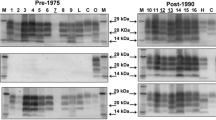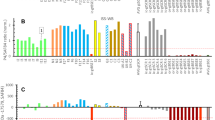Abstract
Scrapie belongs to a group of diseases known as the transmissible spongiform encephalopathies or prion diseases. Two different categories of naturally occurring scrapie have been identified: classical scrapie, which was first recorded around 1750, and atypical scrapie or ‘Nor-98’, which was first identified in Norway in 1998. The molecular characteristics of atypical scrapie have been well defined, but detailed descriptions of the neuropathological phenotype are rare since the majority of cases have been detected through active surveillance programmes where only brainstem and cerebellum are collected for statutory diagnosis. In order to characterise the neuropathology of naturally occurring atypical scrapie in sheep, we examined multiple brain levels from 15 whole brains from field cases of atypical scrapie, both clinical suspects and fallen stock, collected in Great Britain between 2004 and 2006. We found that the distribution of disease-associated prion protein (PrPSc) and vacuolation in atypical scrapie cases are very different to both classical scrapie and experimental bovine spongiform encephalopathy in sheep. Immunolabelling for PrPSc is mild and restricted at the obex and more intense and widespread rostrally, particularly in the cerebellum, substantia nigra, thalamus and basal nuclei. Intracellular immunolabelling types are not seen, but distinctive white matter immunolabelling is widespread. Vacuolation associated with PrPSc deposits was not observed in the brainstem neuroanatomical areas commonly affected in classical scrapie and bovine spongiform encephalopathy, but was instead most prominent in the cerebellar cortex and neocortex. This is the largest comprehensive descriptive study of atypical scrapie pathology to date, and provides baseline data against which other natural or experimental cases can be compared. It also reinforces the current recommendation to collect cerebellum in addition to brainstem to enable confident confirmation of this distinct disease phenotype within surveillance programmes.




Similar content being viewed by others
References
Andréoletti O, Berthon P, Levasseur E et al (2002) Phenotyping of protein-prion (PrPSc)-accumulating cells in lymphoid and neural tissues of naturally scrapie-affected sheep by double-labeling immunohistochemistry. J Histochem Cytochem 50(10):1357–1370
Arnold ME, Ryan JBM, Konold T et al (2007) Estimating the temporal relationship between PrPSc detection and incubation period in experimental bovine spongiform encephalopathy (BSE) of cattle. J Gen Virol 88(11):3198–3208
Baylis M, Chihota C, Stevenson E et al (2004) Risk of scrapie in British sheep of different prion protein genotype. J Gen Virol 85(9):2735–2740
Benestad SL, Sarradin P, Thu B, Schonheit J, Tranulis A, Bratberg B (2003) Cases of scrapie with unusual features in Norway and designation of a new type, Nor98. Vet Rec 153(7):202–208
Benestad SL, Arsac JN, Goldmann W, Noremark M (2008) Atypical/Nor-98 scrapie: properties of the agent, genetics, and epidemiology (review). Vet Res 39:19
Birkett CR, Hennion RM, Bembridge DA et al (2001) Scrapie strains maintain biological phenotypes on propagation in a cell line in culture. EMBO J 20(13):3351–3358
Bruce ME, Nonno R, Foster J et al (2007) Nor98-like sheep scrapie in the United Kingdom in (1989). Vet Rec 160(19):665–666
Buschmann A, Biacabe AG, Ziegler U et al (2004) Atypical scrapie cases in Germany and France are identified by discrepant reaction patterns in BSE rapid tests. J Virol Methods 117(1):27–36
Casalone C, Zanusso G, Acutis P et al (2004) Identification of a second bovine amyloidotic spongiform encephalopathy: molecular similarities with sporadic Creutzfeldt-Jakob disease. Proc Natl Acad Sci 101(9):3065–3070
Collinge J, Sidle KCL, Meads J, Ironside J, Hill AF (1996) Molecular analysis of prion strain variation and the aetiology of “new Variant” CJD. Nature 383:685–690
Defra National Scrapie Plan: atypical cases of Scrapie. Available at http://www.defra.gov.uk/animalH/bse/othertses/scrapie/nsp/atypicalcases/index.htm
De Bosschere H, Roels S, Benestad SL, Vanopdenbosch E (2004) Scrapie case similar to Nor98 diagnosed in Belgium via active surveillance. Vet Rec 155(22):707–708
SA EF (2005) Opinion of the scientific panel on biological hazards on classification of atypical spongiform encephalopathy (TSE) cases in small ruminants. J EFSA 276:1–30
Epstein V, Pointing S, Halfacre S (2005) Atypical scrapie in the Falkland Islands. Vet Rec 157(21):667–668
Everest SJ, Thorne L, Barnicle DA et al (2006) Atypical prion protein in sheep brain collected during the British scrapie-surveillance programme. J Gen Virol 87(2):471–477
Foster J, Toovey L, McKenzie C et al (2008) Atypical scrapie in a closed UK flock with endemic natural classical scrapie. Vet Rec 162(22):723–725
Gavier-Widén D, Nöremark M, Benestad S et al (2004) Recognition of the Nor98 variant of scrapie in the Swedish sheep population. J Vet Diagn Invest 16(6):562–567
González L, Martin S, Begara-McGorum I et al (2002) Effects of agent strain and host genotype on PrP accumulation in the brain of sheep naturally and experimentally affected with scrapie. J Comp Pathol 126(1):17–29
González L, Martin S, Jeffrey M (2003) Distinct profiles of PrP(d) immunoreactivity in the brain of scrapie- and BSE-infected sheep: implications for differential cell targeting and PrP processing. J Gen Virol 84(5):1339–1350
González L, Martin S, Houston FE et al (2005) Phenotype of disease-associated PrP accumulation in the brain of bovine spongiform encephalopathy experimentally infected sheep. J Gen Virol 86(3):827–838
Guiroy DC, Wakayama I, Liberski PP, Gajdusek DC (1994) Relationship of microglia and scrapie amyloid-immunoreactive plaques in kuru, Creutzfeldt-Jakob disease and Gerstmann–Sträussler syndrome. Acta Neuropathol 87(5):526–530
Jeffery M, Goodsir CM, Bruce ME, McBride PA, Fowler N, Scott JR (1994) Murine scrapie-infected neurones in vivo release excess prion protein into the extracellular space. Neurosci Lett 174:39–42
Jeffrey M, Martin S, Gonzalez L, Ryder SJ, Bellworthy SJ, Jackman R (2001) Differential diagnosis of infections with bovine spongiform encephalopathy (BSE) and scrapie agents in sheep. J Comp Path 125:271–284
Jeffrey M, Martin S, González L (2003) Cell-associated variants of disease-specific prion protein immunoimmunolabelling are found in different sources of sheep transmissible spongiform encephalopathy. J Gen Virol 84(4):1033–1045
van Keulen LJ, Bossers A, van Zijderveld F (2008) TSE pathogenesis in cattle and sheep. Vet Res 39(4):24
Klingeborn M, Wik L, Simonsson M, Renström LH, Ottinger T, Linné T (2006) Characterization of proteinase K-resistant N- and C-terminally truncated PrP in Nor98 atypical scrapie. J Gen Virol 87(6):1751–1760
Konold T, Davis A, Bone G, Bracegirdle J, Chaplin M, Simmons MM (2007) Clinical findings in two cases of atypical scrapie in sheep: a case report. BMC Vet Res 3:2
Lawson VA, Collins SJ, Masters CL, Hill AF (2005) Prion protein glycosylation (review). J Neurochem 93(4):793–801
Liberski PP, Bratosiewicz J, Waliś A, Kordek R, Jeffrey M, Brown P (2001) A special report I. Prion protein (PrP)-amyloid plaques in the transmissible spongiform encephalopathies, or prion diseases revisited (review). Folia Neuropathol 39(4):217–235
Lühken G, Buschmann A, Brandt H, Eiden M, Groschup MH, Erhardt G (2007) Epidemiological and genetical differences between classical and atypical scrapie cases. Vet Res 38(1):65–80
McIntyre KM, Del Rio Vilas VJ, Gubbins S (2008) No temporal trends in the prevalence of atypical scrapie in British sheep, 2002–2006. BMC Vet Res 4:13
Moreno CR, Moazami-Goudarzi K, Laurent P et al (2007) Which PrP haplotypes in a French sheep population are the most susceptible to atypical scrapie? Arch Virol 152(6):1229–1232
Moum T, Olsaker I, Hopp P et al (2005) Polymorphisms at codons 141 and 154 in the ovine prion protein gene are associated with scrapie Nor98 cases. J Gen Virol 86(1):231–235
Nentwig A, Oevermann A, Heim D et al (2007) Diversity in neuroanatomical distribution of abnormal prion protein in atypical scrapie. PLoS Pathog 3(6):e82
Onnasch H, Gunn HM, Bradshaw BJ, Benestad ST, Bassett HF (2004) Two Irish cases of scrapie resembling Nor98. Vet Rec 155(20):636–637
Orge L, Galo A, Machado C et al (2004) Identification of putative atypical scrapie in sheep in Portugal. J Gen Virol 85(11):3487–3491
Prusiner SB (1982) Novel proteinaceous infectious particles cause scrapie. Science 216:136–144
Ryder SJ, Spencer YI, Bellerby PJ, March SA (2001) Immunohistochemical detection of PrP in the medulla oblongata of sheep: the spectrum of staining in normal and scrapie-affected sheep. Vet Rec 148(1):7–13
Safar J, Wille H, Itri V et al (1998) Eight prion strains have PrPSc molecules with different conformations. Nature Med 4:1157–1165
Saunders GC, Cawthraw S, Mountjoy SJ, Hope J, Windl O (2006) PrP genotypes of atypical scrapie cases in Great Britain. J Gen Virol 87(11):3141–3149
Scrapie, Chapter 2.4.8 in OIE manual of diagnostic tests and vaccines for terrestrial animals. Available at http://www.oie.int/eng/normes/mmanual/2008/pdf/2.07.13_SCRAPIE.pdf
Simmons MM, Konold T, Simmons HA et al (2007) Experimental transmission of atypical scrapie to sheep. BMC Vet Res 3:20
Somerville RA (1999) Host and transmissible spongiform encephalopathy agent strain control glycosylation of PrP. J Gen Virol 80(7):1865–1872
Spiropoulos J, Casalone C, Caramelli M, Simmons MM (2007) Immunohistochemistry for PrPSc in natural scrapie reveals patterns which are associated with the PrP genotype. Neuropathol Appl Neurobiol 33(4):398–409
Stack MJ, Chaplin MJ, Clark J (2002) Differentiation of prion protein glycoforms from naturally occurring sheep scrapie, sheep passaged scrapie strains (CH1641 and SSBP1), bovine spongiform encephalopathy (BSE) cases and Romney and Cheviot breed sheep experimentally inoculated with BSE using two monoclonal antibodies. Acta Neuropathol 104:279–286
Tongue SC (2006) The diagnosis and relevance of ‘Atypical’ scrapie in Great Britain. Proc Sheep Vet Soc 30:71–75. Available at http://www.sheepvetsoc.org.uk/docs/Proc06/Tongue.pdf
Wells GA, Hawkins SA, Green RB et al (1998) Preliminary observations on the pathogenesis of experimental bovine spongiform encephalopathy (BSE): an update. Vet Rec 142(5):103–106
Acknowledgments
We would like to thank the VLA regional laboratories for collection of samples, the staff of the Neuropathology and Histopathology groups (VLA Weybridge) for processing of tissues, staff of the Molecular Pathogenesis and Genetics department (VLA Weybridge) for performing the Western blotting, Lorenzo Gonzalez (VLA Lasswade) for training and advice on PrPd profiling, and Alberto Vidal-Diez (VLA Weybridge) for assistance with statistical analysis.
Author information
Authors and Affiliations
Corresponding author
Rights and permissions
About this article
Cite this article
Moore, S.J., Simmons, M., Chaplin, M. et al. Neuroanatomical distribution of abnormal prion protein in naturally occurring atypical scrapie cases in Great Britain. Acta Neuropathol 116, 547–559 (2008). https://doi.org/10.1007/s00401-008-0433-8
Received:
Revised:
Accepted:
Published:
Issue Date:
DOI: https://doi.org/10.1007/s00401-008-0433-8




